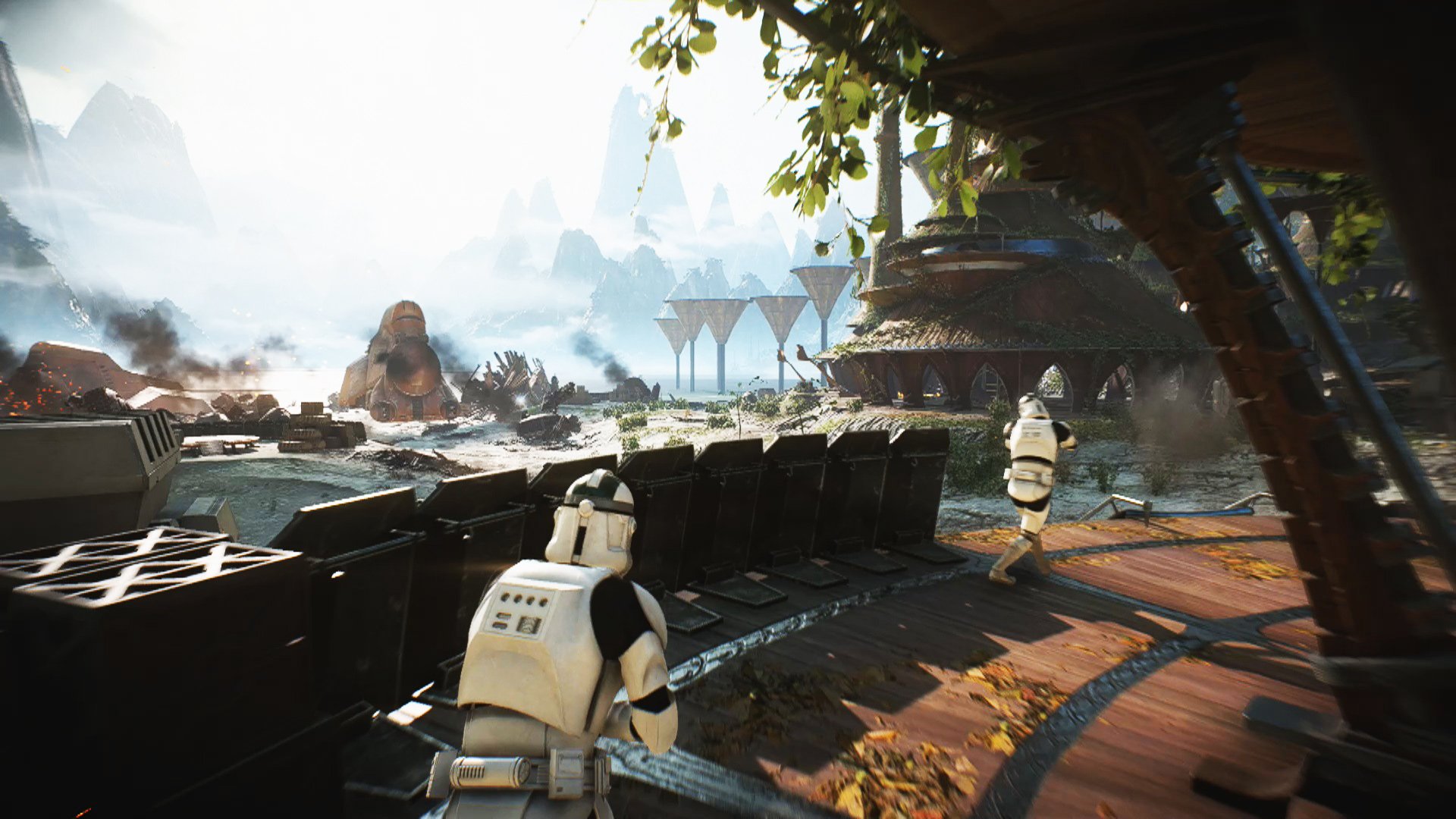Battlefront 2 Stuttering & Lag Spike Fix
The days of the Star Wars Battlefront date back nearly two decades, when the first iteration was released in 2004. It’s one of the most well-received shooters ever, and not just because of nostalgia. This game has serious merit.
In 2005, it was followed up by the even better-received Battlefront II. Since then, gaming has come a long way in terms of technology and popularity, but these games remain beloved.
Nonetheless, EA took on the hefty challenge of remaking these games with modern twists and mechanical updates. While the graphical accomplishments of EA’s Battlefront and Battlefront 2 are highly commendable, the games are notorious for significant problems.
Thankfully, these problems have been largely fixed to this point. Battlefront 2, in particular, is finally in a good place where its dedicated community can truly enjoy it.
However, one serious problem remains. It’s a problem all gamers have dealt with at one point or another, and one we all hate: lag.
Lag may seem inevitable to the gamer, but we’re here today to talk about how new technology offers us better weapons in the fight against this age-old enemy.
In today’s day and age, where online play is critical for most games, optimizing your connection and eliminating lag is one of the most fundamental steps you can take towards finding the most enjoyable gaming experience possible.
So sit back, relax, and read on for today’s guide to wiping lag from your gaming galaxy!
Understanding Your Lag
Understanding your enemy is the first step to victory. These may sound like the words of a Jedi master, but they’re the basis of the best strategy to overcome lag.
After all, how would we find a solution if we don’t know the problem? Lag is a fairly broad term with many potential meanings and applications. Lag could mean anything from tiny drops in framerate to poorly setup loading screens to actual issues with your hardware and network that make a game unplayable.
Before we talk about solutions, let’s break down the classes and causes of lag.
We'll define lag first to make sure we’re on the same page. Lag is an irregular delay in visuals, audio, or input translation. Not every glitch or issue you encounter is considered lag, and not all lag is particularly noticeable at first either.
What Are Common Types of Lag in Battlefront 2?
While playing Battlefront 2, there are a few common types of lag you’ll encounter, including stutter, microstutter, packet loss, and rubberbanding. Some of these types of lag are specific to online gaming, while others are a pox on offline gamers too.
Stutter
The most common type of lag in Battlefront 2 is something known as stutter. Like the eponymous speech impediment, stutter is a delay or irregular repetition. Typically, stutter translates to issues with framerate sync: aka a minor visual glitch, such as your character freezing up for a second or the environment failing to render for a very short moment.
Sometimes stutter can be more significant. In any case, it’s likely to impact gameplay negatively. Particularly in a shooter such as Battlefront, where precision and speed are so important, stutter lag can seriously hurt your win rate by causing unnecessary losses.
Microstutter
Similar but much less significant, microstutter is another type of lag where your FPS drops in relatively small and rarely noticeable measures, depending on the game you’re playing and what your goals are.
Nonetheless, if you track your FPS or otherwise notice the game becomes a bit less smooth occasionally, you may have this kind of lag in your game.
Packet Loss
Packet loss is another type of lag centered around something known as ping. Ping is the measure of time it takes your packets (i.e., data) to travel from your device to the online network. Packet loss means your data took too long or never arrived.
In other words, when you do something in-game or when something happens that you need to see, a packet gets sent. If this takes too long, then your actions (such as jumping, shooting, or aiming) or those of other players might take too long or not even occur.
Packet loss can be game-breaking, but it’s also only relevant during online play. Alternately, stutter and microstutter can occur on or offline.
Rubberbanding
Another type of online-only lag is rubberbanding. You’re likely familiar with this already. Just picture the classic hilarity of your character getting stuck bouncing back and forth between a point as though a rubber band keeps pulling them back.
It’s funny to watch in someone else’s stream, but rubberbanding can really ruin your game. Being unable to move to safety or chase down an objective can turn a win into a loss in such a time-sensitive game like Battlefront 2.
What Are Some Common Lag Fixes?
There are a number of tips and tricks you can employ to erase lag from your gaming, some more time-consuming or less direct than others. Whether you’re playing online matchmaking or enjoying some of Battlefront 2’s single-player content, these steps could help you.
Update Your Hardware
One of the first and simplest steps is to ensure your hardware is up to spec and your settings are where they should be. Running the game on a device that doesn’t meet the minimum requirements is a sure-fire way to end up with lag.
Don’t use the highest graphical settings if you’re experiencing lag, even if you meet the recommendations. Turning these down and switching off certain options such as V-Sync can help things run more smoothly.
Your graphics drivers might also need updates, so it never hurts to check on these occasionally. You can also keep automatic update downloads or reminders on if you have that option.
Another simple way to optimize your hardware situation is to close any background tasks you might have running. Discord is fine, although you could always run your voice chat on a mobile device. Everything else should be closed.
Even closing the Steam store and apps you use for homework or work can help keep your RAM as free as possible.
Examine Your Network
If you’re playing online and the hardware fixes above don’t work, your next step is looking into network solutions.
Internet speed and stability are the two factors to consider, both of which can be measured by running a ping test. To improve your results, you should run your game on a device using a wired connection.
Wireless connections tend to be unreliable. Wired connections, such as ethernet, offer better stability and speed in almost every case.
High ping may also be due to high traffic on your network. Pause any downloads, uploads, or streams you may have going while you game.
Try a GPN
It can take a lot of effort to troubleshoot every time you experience lag. Thankfully, there’s a simpler solution.
Our GPN is a modern twist on VPN technology designed specifically and exclusively for gaming. We configure everything for you (unless you want more control) to optimize your connection for gaming in every way.
Starting with speed, we find the fastest traceroute for your data so it can travel to and from the game server at the lowest ping possible. We also only send your game session data because a clear path can be traveled fastest.
On the other hand, VPNs aren’t built for speed at all. They may have useful functions in terms of privacy, but that’s where it ends. Depending on their settings, most VPNs are chock-full of traffic within their servers. This can seriously slow down your ping, especially when the traffic jam is a dense activity such as streaming and downloading (common on VPNs).
Next, we ensure a more stable connection. Pesky lag spikes, FPS drops, rubberbanding, and stutter are massively reduced, leading to greater loss aversion and more consistency in smooth gameplay.
Something else we were careful to ensure, unlike VPNs, is that your connection settings comply with your game of choice. Since VPNs can be used to bypass certain restrictions or to hide nefarious activity such as fraud, botting, and hacking, many developers and game distribution companies like Steam restrict or ban VPNs.
To be as safe as possible and avoid any hassle with customer service teams or EA’s Origins, our WTFast GPN doesn’t mask your IP address or change your network settings in any way. It’s the same as your normal connection, just much faster and more reliable.
Wrapping Up
WTFast GPN is the ultimate secret weapon against lag. Don’t play another day with lag looming and lessening your experience – sign up now and enjoy lag-free gaming for all your favorite games like Battlefront 2 and beyond.
Sources:


